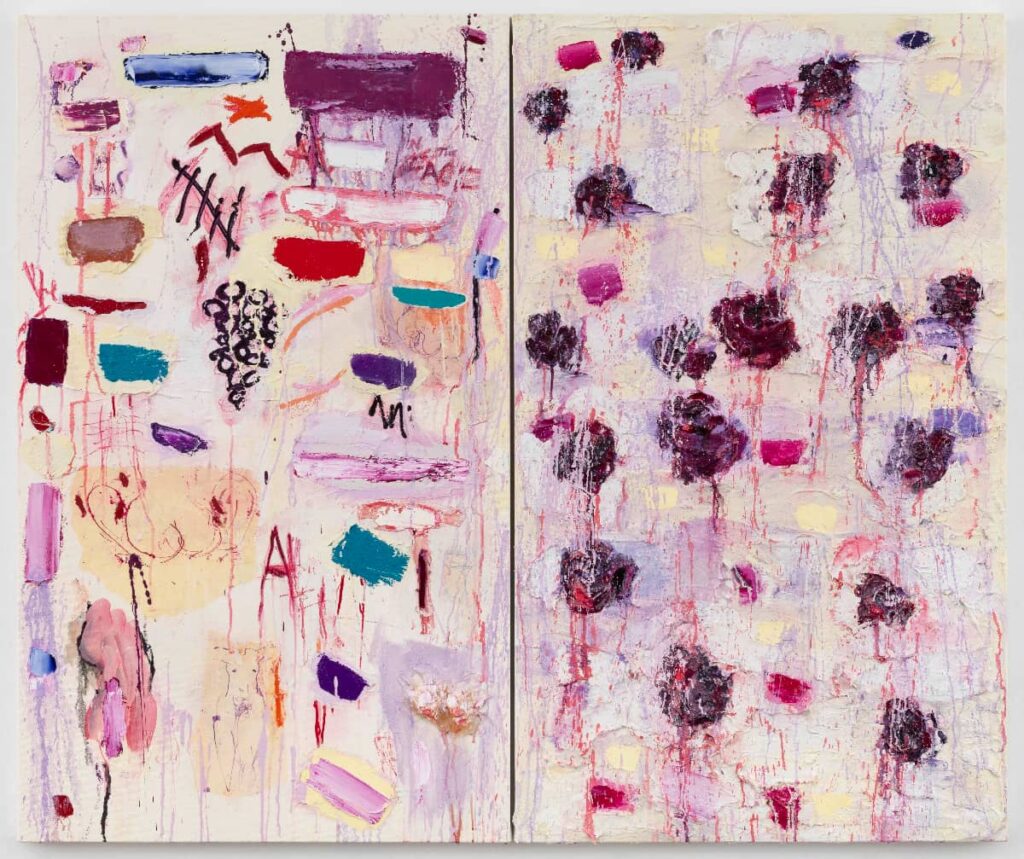Canada Gallery Showcases Joan Snyder’s Vibrant, If Not Eye-Searing, Maximalism
Like Paul Klee, who also attempted to paint the listening experience, she performs her own style of sonic transcription.

Joan Snyder: ‘Come Close’
Canada Gallery, 60 Lispenard Street, New York, NY
January 12 – February 24, 2024
Joan Snyder, who first came to prominence in the 1970s with her “stroke” paintings, is the subject of a broad and cheerful retrospective at Canada gallery. 13 new works are introduced in the show, featuring rhythmic, musically inspired works alive with inventiveness and color. Ms. Snyder, who is 83, has been practicing her craft assiduously for the last six decades and shows no sign of slowing up. These paintings are as fresh and alive as any of her work from previous eras.
Ms. Snyder is known to base her paintings on compact drawings she has always made since the start of her career. Like Paul Klee, who also attempted to paint the listening experience, she performs her own style of sonic transcription. She creates marks, squiggles, and washes in notebooks while listening to live music — opera is a reported favorite — often annotating thoughts and feelings in the margins. It is this insistent desire of hers to translate the immediacy of sensuous experience into painting that makes her practice so vivid and engaging.
Ms. Snyder doesn’t skimp on technique or approaches, as is amply evident when walking into the show. She uses acrylic, oil, impasto, encaustic, collage, the odd word, handprints, as well as applications of leaves, flowers, and twigs gathered from nature. These elements are then rhythmically arranged on raw linen surfaces, often with an added layer of burlap. The textural quality of her paintings is most recognizable in person, and the richness is striking. Coming out of a generation of artists known mostly for minimalism and “negative capability,” Ms. Snyder is a maximalist.

It is not merely all gesture and feeling, however. Ms. Snyder has long kept a catalog or index of abstract shapes and motifs with which she populates her canvases, reiterating them and combining them in a sort of self-invented visual syntax. Her notebooks are an index of these shapes, squiggles, and motifs, and she has been using and re-using them consistently.
In the long and relentlessly vibrant “Autobiography,” we can see how Ms. Snyder uses these elements contrapuntally, in the manner of a master composer. A triptych, we can see that she divides the painting into three sections devoted to three different types of motifs. A dance of fuchsia and rose smudges against a plum background occupies the first panel, surrounded by a thick raised impasto frame of metallic silver. A parliament of cream and maroon blobs and rectangles inhabits the second, all against a dark raw linen background. The third is a series of rose and cream horizontal stripes, relieved by a single stripe of aquamarine. The effect is busy and enchanting, all at once.
Roughly speaking, there appear to be four basic elements in Ms. Snyder’s painting. There are nest-like circles and occasionally squares, often lined with vegetative material or twigs. These are generally dark inside and open sections of the canvas like portals. There are rectangular impasto smears of paint which can populate an entire area. Then there are horizontal lines which she stacks in an echo or homage to color field painting. These elements speak to each other in a way that verges on the metaphysical. Ms. Snyder has harnessed the ability to make the elements of her paintings converse with each other in a manner that hints at understanding just past language.
The most unifying element of hers, however, is color. Just as the diverse instruments of a symphony blend to create a unified sound, Ms. Snyder unifies her menagerie of gestural elements and shapes through color. It is often vibrant, if not eye searing. The palette leans heavily towards fuchsia and burgundy, with occasional accents of vermillion, yellow, and aquamarine. Just as with her shapes, she employs a well-rehearsed range of color, which she reiterates and deploys with facility.
Ms. Snyder seems particularly enamored of the contrast of roses and pinks on the burnt sienna of raw canvas, and it is a pleasing color contrast. She is equally pleasing, however, when she cools things down, as in the painting “Sub Rosa II,” where lighter shades of fuchsia, purple, and rose fade into an off-white background. Its panoply of elements creates palpable movement on the painting’s surface, while its creamy background, with hints of butter yellow, sets off similar rhythmic and contrapuntal figure ground relationships. It all moves and grooves together, in other words.
The city seems alive with older painters hitting new heights after decades of practice. Ms. Snyder, with her long-established syntax of form and color enlivened by her love for music, is most certainly one of them.

